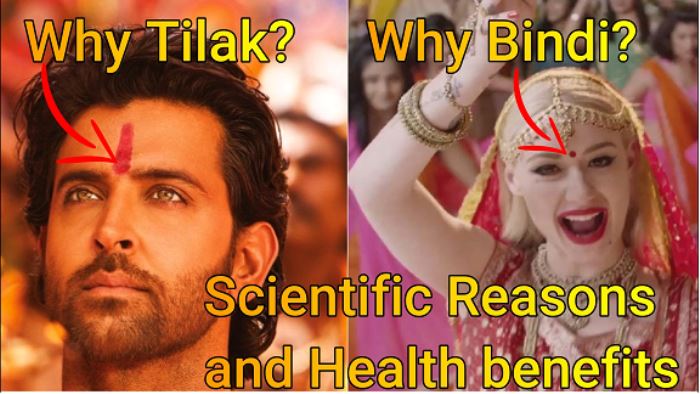
Why Bindi or Tilak on Head. Scientific Reasons and Health benefits
You may have often seen women wearing a bindi on her forehead or men sporting a tilak on his forehead. But you may not know why the bindi is adorned by womens and what are its spiritual significance and health benefits. So, in this article, we will go through the various reasons why the bindi or tilak is applied on the forehead and what are its health benefits
Check the below video for graphical explanations on Scientific Reasons, Spiritual Reasons and Health benefits of wearing Bindi.

Origin & types of Bindi/Tilak
W ord bindi comes from the Sanskrit word ‘bindu’, meaning dot. Bindu appears in the hymn of Creation known as Nasadiya Sukta, the earliest know n Sanskrit Text of the Rigveda. Bindu is dot/point at which Creation begins and is considered as the sacred symbol of the Cosmos in its “Unmanifested State”.
In ancient times since childhood , both men and women after bathing wore the bindi or tilak on their forehead. In the 16 decorations for personal grooming (solah-shrungâr), bindi is the first shrungaar and has a strong religious implication. So, First Red Bindi is usually applied in the marriage ceremony, where the groom makes a 'tilaka' mark on the bride's forehead. It is called the "Sindoor Dana" ceremony. Thereafter, Married women's wear a large red bindi exclusively called as 'sindura' or 'sindoor' or KumKum as Red represented Shakti (strength) and symbolizes love and prosperity. . It grants her a place as the guardian of the family’s welfare and progeny. In fact,
Men wore a tilak made of chandan or Ash. Unmarried or widowed women would wore Black Bindi to ward off the evil eye.

Historical References of Bindi/Tilak
The practice of using 'kumkum' on foreheads is also mentioned in Vedic texts, Purânas, the Lalitha Sahasranâma and Âdi Shankara’s Soundarya Lahiri. In the famous eight verses (astakam) on the symbol of Lord Shiva called the ‘Lingashtakam’ the composer says “Kumkuma chandana lepitha lingam..” meaning “I bow before that symbol (lingam), which represents the eternal Lord Shiva, adorned by sandal paste and kumkum”.
Sant Tulsidâs mentions it in his Râmcharitmânas at the time of the marriage between Lord Ram and Sitâ.
After cheer-haran at Hastinâpur, Pândava queen Draupadi wiped her 'kumkum' off the forehead in anguish.
Mention of Tilak is also found in Mahâkavi Kâlidasa poetic works and other works like Panchatantra.
Forehead of women sculptures excavated in many ancient sites like Ajantâ or Ellora caves, khajuraho temple & Râjasthani paintings were found decorated with bindi .
Ingredients of Bindi/Tilak and its benefits
Originally, Bindi was made from the yellow or red sandalwood, red and yellow turmeric, saffron, various flowers & ash as all these ingredients had natural cooling properties .
Turmeric is grown underground; hence along with its anti-bacterial and other elementary elements, it also has blessings of mother earth. Since turmeric is obtained from earth, it naturally has the power of absorption and tolerance.
Kumkum was made by mixing turmeric and lime. This mixture is highly hygroscopic in nature (has the ability to absorb water) and therefore had the ability to absorb any ‘water’ or mucous logged in the head. Apart from that the mixture is antibacterial in nature and reduces the risk of bacterial infections.

Chandan is known for its cooling properties. This compound is known to benefit the skin and cool the nerves below it. It helps in keeping the mind calm and cooling the entire system, especially if you are residing a tropical country
Spiritual Significance/Benefits of Tilak/Bindi
The area between the two eyebrows is the sixth chakra, known as Agna chakra. Ajna translates as “command” or “perceive,” and is considered to be the seat of person's wisdom, intuition & knowledge. This point is responsible for proper functioning of the whole body and manages the concentration of mind. Bindi/Tilak enhances the powers of this chakra, specifically by cultivating one’s ability to access their inner wisdom, allowing them to view the world and interpret the creation in a truthful, unbiased manner as well as forsake their ego, control their anger and get rid of illusionary things.
When the person is enlightened after eons of meditation, this area becomes the mystical third eye that has the power of creation and destruction. According to Vedas, all people have a third inner eye; the two physical eyes are used for seeing the external world, while the third one focuses inward toward God. An enlightened person can see the god and his divine creations via this activated third eye.
As many cannot sit in prayers for the whole today, they wear the red mark (Tilak/Bindi) at the area around third eye that serves as a constant reminder of keeping god at center of one's thought and always keep in mind that all the activities one perform should be for self-realization of god.

Also, Wearing the bindi between the brows protects a woman from the negative attacks of lust around her. There is a flow of divine consciousness from the kumkum which forms a protective sheath around the woman protecting her from all negativity
Health benefits of Tilak/Bindi
These are several health benefits of wearing a bindi. Some of them are:-
1. Relieves headaches.
According to principles of acupressure, this spot is a converging point of numerous nerves and blood vessels. Hence, pressing the spot for few seconds relieves headache.
2. Clears up your sinuses.
Pressing this point stimulates the trigeminal nerve, that is responsible for sensation in the entire face. When stimulated, this nerve increases the blood flow to the nasal passage, mucosal lining of the nose and sinuses. Therefore, it helps in relieving a blocked nose, relieves nasal congestion and also helps in reducing the swelling within the sinuses.
3. Improves vision and eye health.
The center point of the forehead is directly connected to the supratrochlear nerve. This nerve is a branch of the frontal nerve, which in turn is a branch of the ophthalmic division of the trigeminal nerve. It is connected to all the muscles around the eyes. Stimulating this nerve activates the muscles of the eyes which helps in changing the shape of the eyes, thereby improving the eye vision and eye health.

4. Strengthens your facial muscles and can beat wrinkles:
When the supratrochlear artery, and the supratrochlear vein are stimulated, muscles of the face also gets stimulated and there is increased flow of blood in all the facial muscles. This helps in retaining the stiffness of the muscles, nourishes the skin and removes wrinkles
5. Can help relieve the symptom of Bell’s palsy:
Bell’s palsy is a condition where one part of the face becomes paralyzed. Massaging this point activates the muscle known as the procerus muscle that is present right between the eyebrows. This muscle is connected to temporal nerves that contains nerve fibers of cranial muscle five (CNVII). CNVII is responsible for the movement of all the facial muscles.
Treatment of this disease via massage of this point can be found in Panchakarma wing of Ayurveda, where the therapy is called ‘ shirodhaara‘. In this therapy the practitioner pours medicated oil continuously on the center of the forehead for about 40-60 minutes.
6. Prevents depression.
The trigeminal nerve is such a key nerve that stimulating this nerve with very low intensity electrical shocks treats depression, epilepsy and post-traumatic stress disorder (PTSD). By pressing this nerve for a few seconds every day, you can prevent these conditions in the first place!
7. Improves hearing.
One of the nerves passing through this anga area also stimulates your cochlear, which is the most important part of the inner ear that is key to hearing. Therefore stimulating this point impairs the hearing loss and keeps the ears healthy
8. Relieves stress and calms the mind.
This point is also very closely linked to the pineal gland that produces the hormones serotonin and melatonin. Melatonin is the sleep hormone, whereas serotonin is one of the hormones related to happiness. So, massaging this point on a daily basis activates the muscles and nerves in this area thereby calming the mind and entire body.
Moreover, the pituitary gland is situated behind the Ajna Chakra. The pituitary gland is the master gland and controls the function of all other glands in our body. When the pituitary gland is balanced and working, our body is balanced and relaxed .
9. Relieves stress, eye strain, fatigue and insomnia.
This spot heats up throughout the day as we use our brain and so, In Ayurveda, this spot is advised to be massaged for relive ing stress and insomnia. Stimulating this point relaxes the face, neck and upper body to such an extent that it prevents insomnia and promotes restful sleep.
10. Boosts memory and concentration.
According to both yoga and acupressure, stimulating this point boosts memory and concentration. Sandalwood paste (Chandan) or ash is advised to be applied on this spot to keep the nerves cool and conserve energy.
11. Improves intuition and awareness.
According to pranayama, this spot is linked to intuition, creativity, spiritual awareness, visualization, wisdom, intellect and understanding. During meditation, latent energy (Kundalini) rises from the base of the spine towards the head with Agna an outlet. Now, Bindi helps in retaining this energy in the human body and controls the levels of concentration.
Avoid using Modern artificial Bindis
Today, we see decorated & artifical bindis in different colors and designs to match their daily outfits, or fancy ones for their fancy dresses . Bindi is popular not just in South Asian countries, but also in the western world. Many celebrities like Nicole Scherzinger , Vanessa Hudgens, Gwen Stefani & Selena Gomez have been seen wearing Bindi. But it has lost its meaning and is largely regarded as a beauty accessory or a part of women’s fashion. Such decorated or artifical have little or no effect in removing stress and insomnia & achieving all the above benefits

Conclusion:-
Thus, we have seen that wearing Bindi is an act of w orship ping the intellect s o as to ensure that thoughts, speech, actions, behavior and ultimately one's character is pure & righteous . A strong intellect help s one in taking noble decisions in life, be able to stand up to challenges in life with courage, and recognize and welcome good thoughts in life . The belief is that on this, a strong individual, a strong family and strong society can be formed
As an Indian proverb says "A woman's beauty is multiplied 1,000 times when she wears a bindi", keep wearing Bindi/Tilak for exquisite beauty and various health benefits
Note: Images used on this website
are either a production of Bhaktivedanta Book Trust(https://www.krishna.com), Iskcon
Foundation or were found in google search under "Free to use and share". If any
of the images presented here violates copyright issues or infringes anyone copyright
or are not under "Fair use", then please bring it to our notice. Read
Disclaimer for more.
Share this to your friends. One of your friend is
waiting for your share.
Related Articles
How sages and mystics communicates with god
Does kung fu has its origin in india
Jantar Mantar-Temple of instruments
Science in Hinduism-Big bang,Creation & destruction of universe
Science in hinduism-Evolution in vishnu avatars part 2
Symbolism of story behind kumbh mela-world largest gathering on earth
Science in Hinduism-Large numbers and infinity
Why number 108 is holy and auspicious in Hinduism
Symbolism of kumbh mela in sikhism
How chanting AUM controls blood pressure and heart diseases
Post Comment